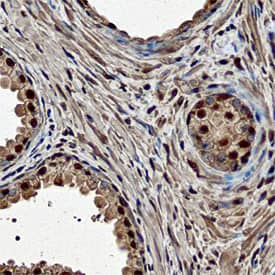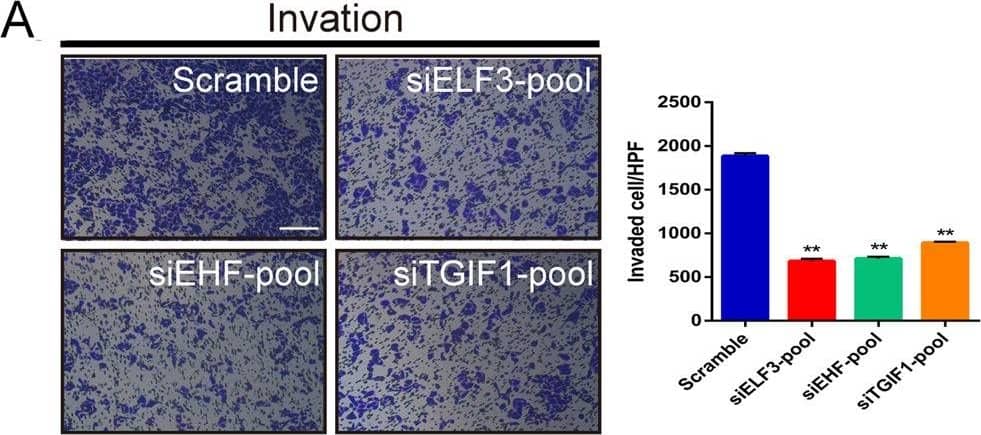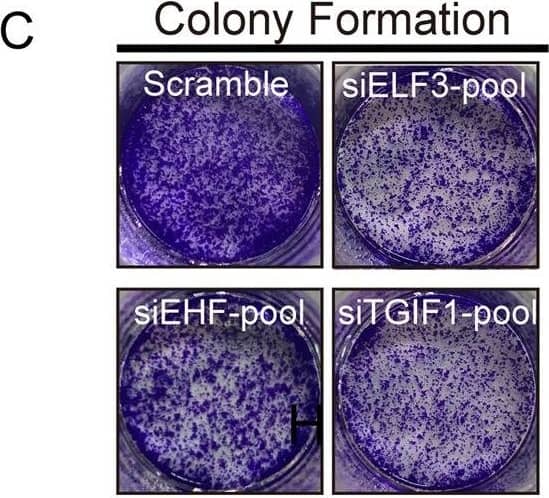Human ELF3 Antibody Summary
Met1-Gly173
Accession # P78245
Applications
Please Note: Optimal dilutions should be determined by each laboratory for each application. General Protocols are available in the Technical Information section on our website.
Scientific Data
 View Larger
View Larger
ELF3 in Human Prostate. ELF3 was detected in immersion fixed paraffin-embedded sections of human prostate using Mouse Anti-Human ELF3 Monoclonal Antibody (Catalog # MAB57871) at 15 µg/mL overnight at 4 °C. Before incubation with the primary antibody, tissue was subjected to heat-induced epitope retrieval using Antigen Retrieval Reagent-Basic (Catalog # CTS013). Tissue was stained using the Anti-Mouse HRP-DAB Cell & Tissue Staining Kit (brown; Catalog # CTS002) and counterstained with hematoxylin (blue). Specific staining was localized to nuclei of glandular epithelial cells. View our protocol for Chromogenic IHC Staining of Paraffin-embedded Tissue Sections.
 View Larger
View Larger
Detection of Human ELF3/ESE-1 by Immunohistochemistry ELF3, EHF, and TGIF1 enhances the malignant phenotypes of LUAD cells.A, B Inhibition of invasive and migrate activity by knockdown master TFs, ELF3, EHF, and TGIF1. PC-9 cells were transfected with indicated siRNA-pool and subjected to invasion and migration assays (see “Materials and methods”). Invaded and migrated cells were stained with crystal violet and counted (see Fig. S3). Histograms represent the number of invasion or migration. Representative photographs were shown. C Colony assay performed on PC-9 cells transfected with either scramble or siRNA-pool targeting ELF3, EHF, and TGIF1. D Silencing of ELF3, EHF, and TGIF1 increased clonal cell growth in a 3D spheroid culture system. PC-9 cells transfected with scramble or siRNA-pool were cultured as spheroid in DMEM medium and the spheroids was observed after 48 h. E Inhibition of cell migration by knockdown master TFs, ELF3, EHF, and TGIF1. PC-9 cells were transfected with indicated siRNA-pool and subjected to scratch assay (see “Materials and methods”). Representative photographs were taken and migration areas were measured. Statistical analysis was performed by using t tests; data are shown as bar graphs of the mean ± SD. of three independent experiments. Scale bars (white) indicate 250 μm. F The effects of pcDNA3.1-ELF3 and/or pcDNA3.1-EHF co-transfected with TGIF1 siRNA on cell migration and invasiveness in LUAD cells were examined by Transwell assays using a Boyden chamber in the presence or absence of Matrigel, respectively. Histograms represent the number of invasion or migration. Data were representative of two to three separate experiments performed in triplicate. *p < 0.05; **p < 0.01; ***p < 0.001. Image collected and cropped by CiteAb from the following publication (https://pubmed.ncbi.nlm.nih.gov/33070167), licensed under a CC-BY license. Not internally tested by R&D Systems.
 View Larger
View Larger
Detection of Human ELF3/ESE-1 by Immunohistochemistry ELF3, EHF, and TGIF1 enhances the malignant phenotypes of LUAD cells.A, B Inhibition of invasive and migrate activity by knockdown master TFs, ELF3, EHF, and TGIF1. PC-9 cells were transfected with indicated siRNA-pool and subjected to invasion and migration assays (see “Materials and methods”). Invaded and migrated cells were stained with crystal violet and counted (see Fig. S3). Histograms represent the number of invasion or migration. Representative photographs were shown. C Colony assay performed on PC-9 cells transfected with either scramble or siRNA-pool targeting ELF3, EHF, and TGIF1. D Silencing of ELF3, EHF, and TGIF1 increased clonal cell growth in a 3D spheroid culture system. PC-9 cells transfected with scramble or siRNA-pool were cultured as spheroid in DMEM medium and the spheroids was observed after 48 h. E Inhibition of cell migration by knockdown master TFs, ELF3, EHF, and TGIF1. PC-9 cells were transfected with indicated siRNA-pool and subjected to scratch assay (see “Materials and methods”). Representative photographs were taken and migration areas were measured. Statistical analysis was performed by using t tests; data are shown as bar graphs of the mean ± SD. of three independent experiments. Scale bars (white) indicate 250 μm. F The effects of pcDNA3.1-ELF3 and/or pcDNA3.1-EHF co-transfected with TGIF1 siRNA on cell migration and invasiveness in LUAD cells were examined by Transwell assays using a Boyden chamber in the presence or absence of Matrigel, respectively. Histograms represent the number of invasion or migration. Data were representative of two to three separate experiments performed in triplicate. *p < 0.05; **p < 0.01; ***p < 0.001. Image collected and cropped by CiteAb from the following publication (https://pubmed.ncbi.nlm.nih.gov/33070167), licensed under a CC-BY license. Not internally tested by R&D Systems.
 View Larger
View Larger
Detection of Human ELF3/ESE-1 by Immunohistochemistry ELF3, EHF, and TGIF1 enhances the malignant phenotypes of LUAD cells.A, B Inhibition of invasive and migrate activity by knockdown master TFs, ELF3, EHF, and TGIF1. PC-9 cells were transfected with indicated siRNA-pool and subjected to invasion and migration assays (see “Materials and methods”). Invaded and migrated cells were stained with crystal violet and counted (see Fig. S3). Histograms represent the number of invasion or migration. Representative photographs were shown. C Colony assay performed on PC-9 cells transfected with either scramble or siRNA-pool targeting ELF3, EHF, and TGIF1. D Silencing of ELF3, EHF, and TGIF1 increased clonal cell growth in a 3D spheroid culture system. PC-9 cells transfected with scramble or siRNA-pool were cultured as spheroid in DMEM medium and the spheroids was observed after 48 h. E Inhibition of cell migration by knockdown master TFs, ELF3, EHF, and TGIF1. PC-9 cells were transfected with indicated siRNA-pool and subjected to scratch assay (see “Materials and methods”). Representative photographs were taken and migration areas were measured. Statistical analysis was performed by using t tests; data are shown as bar graphs of the mean ± SD. of three independent experiments. Scale bars (white) indicate 250 μm. F The effects of pcDNA3.1-ELF3 and/or pcDNA3.1-EHF co-transfected with TGIF1 siRNA on cell migration and invasiveness in LUAD cells were examined by Transwell assays using a Boyden chamber in the presence or absence of Matrigel, respectively. Histograms represent the number of invasion or migration. Data were representative of two to three separate experiments performed in triplicate. *p < 0.05; **p < 0.01; ***p < 0.001. Image collected and cropped by CiteAb from the following publication (https://pubmed.ncbi.nlm.nih.gov/33070167), licensed under a CC-BY license. Not internally tested by R&D Systems.
Reconstitution Calculator
Preparation and Storage
- 12 months from date of receipt, -20 to -70 °C as supplied.
- 1 month, 2 to 8 °C under sterile conditions after reconstitution.
- 6 months, -20 to -70 °C under sterile conditions after reconstitution.
Background: ELF3
ELF3 (E74-Like Factor 3; also ESE-1, ESX, ERT and JEN) is a 41-43 kDa member of the ETS family of proteins. During uncomplicated (non-inflammatory) periods of cell differentiation, ELF3 is expressed exclusively by epithelial cells, repressing genes needed during early differentiation, and promoting genes needed for full differentiation. Under conditions of inflammation, cells such as monocytes, endothelial cells and chrondrocytes will express ELF3 and produce molecules such as Ang1 and COX2. Human ELF3 is 371 amino acids (aa) in length. It contains one PNT/pointed dimerization domain (aa 46-132), a protein stabilizing PEST sequence (aa 210‑225), an A/T Hook region that binds to AT-rich DNA sequences (aa 236-252), and an ETS DNA binding domain (aa 273-355). ELF3 interacts with CREBBP, EP300, KU70 and KU86. There is one splice variant that shows a deletion of aa 174-200. Over aa 1-173, human ELF3 shares 87% aa identity with mouse ELF3.
Product Datasheets
FAQs
No product specific FAQs exist for this product, however you may
View all Antibody FAQsReviews for Human ELF3 Antibody
There are currently no reviews for this product. Be the first to review Human ELF3 Antibody and earn rewards!
Have you used Human ELF3 Antibody?
Submit a review and receive an Amazon gift card.
$25/€18/£15/$25CAN/¥75 Yuan/¥2500 Yen for a review with an image
$10/€7/£6/$10 CAD/¥70 Yuan/¥1110 Yen for a review without an image
